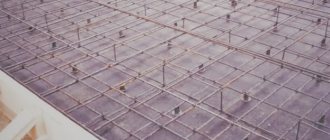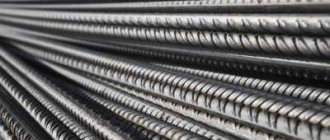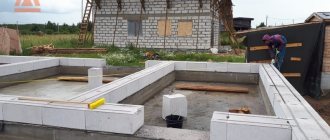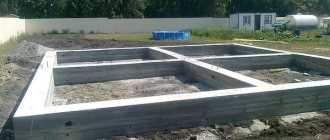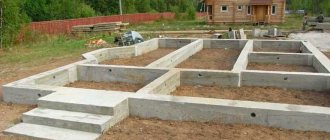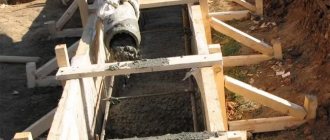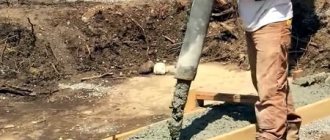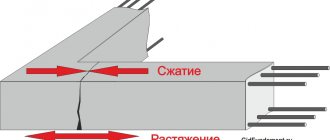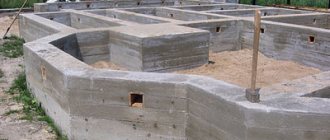Private developers planning to build a house, garage, or household facilities with their own hands have to independently calculate the reinforcement for a strip foundation and solve many problems, hoping for help and tips from Internet resources and familiar craftsmen.
Some of them are of the opinion that they do not have to do calculations. Following the principles of strict economy, they often strengthen the concrete pour with any means at hand, including wire, old pipes, and other metal.
This approach is quite risky. Over time, in the event of deformation of wall structures, correcting errors will be very labor-intensive and expensive. In the future, this may lead to difficulties associated with the instability of the house and difficulties with its operation. It is better, as they say, to first measure several times and then act.
Calculation of reinforcement for the foundation
The reliable information presented to your attention in this article will help you easily carry out calculations: determine the diameter and footage of an iron rod, choose a knitting pattern for a frame or lattice, without resorting to the paid services of enterprising specialists.
Rolled metal, which is used in the construction of reinforced concrete structures, performs the most important functions to ensure durability and safety. By correctly combining corrugated and smooth rods, builders create a strong frame, which will subsequently take on most of the loads and prevent the formation of deformations - deflections, shedding and cracking of concrete.
There are various methods that allow you to quickly and fairly accurately determine how much reinforcement is needed for the foundation, both through a professional approach and “by eye”, based on the experience of the craftsmen. Before mastering them in order to reduce costs, you should pay attention to the quality of the purchased material - its grade, steel grade, thickness, weight and type of surface (corrugated or smooth).
The choice should be based on the requirements of GOST 5781-2003, according to which the domestic industry produces 5 classes of profile metal products:
- I and II are smooth rolled metal, supplied in coils or rods with d from 10; 12; 16 to 40 mm.
- III is a rod with corrugation of various depths and modifications. This category is marked as A III, the range is supplied with different section thicknesses.
- IV and V are assigned to metal products that can withstand the highest overloads that are typical for high-rise buildings and special-purpose real estate.
On a note.
In recent years, products based on specifications have become widespread, the marking of which may not correspond to the classification according to GOST. In such cases, their characteristics should be clarified with the seller.
Purpose of reinforcement
The reinforcement resists loads on the foundation from the soil and the building itself. Strip foundations are a monolithic foundation structure made of reinforced concrete. The base is made directly at the construction site.
Reinforced concrete is concrete, inside of which there is a metal frame made of reinforcement. Metal allows you to withstand lateral loads that create:
from bottom to top - soil heaving processes; from top to bottom the mass of the building. Pure concrete resists lateral loads poorly. Steel embedded inside the structure can make the foundation tens of times stronger.
Under load, each meter of concrete can stretch by 2–4 mm, while steel can stretch from 4 to 25 mm. Concrete withstands compression many times better.
Basics of calculating strip foundations
The foundation strip is a monolithic closed loop. It serves as the basis for walls, preventing their deformation under the influence of various natural and operational factors.
When starting to calculate the volume of reinforcement in a strip foundation, you must take into account the shape of the sections, which are made up of metal profiles connected by wire clamps in 2 directions:
- 1. Longitudinal - 2 belts.
- 2. Transverse - double-sided inserts with jumpers.
To select the right home builder for your desired low-rise housing construction technology, use the Building Companion directory search. Examples of work and reviews are visible in the contractors' profiles; you can request an estimate of the cost of their work. Find a company to build a box house »
Using calculators
Not all developers are able to tinker with calculations of the need for reinforcement. There is also a risk of mistakes made during foundation design. Online calculators help you accurately calculate how many and what type of steel rods need to be prepared to form the reinforced frames of a poured foundation.
Services request initial parameters such as:
Base length.- Tape width.
- Sole depth.
- Diameters of longitudinal, vertical and transverse reinforcement.
- The number of longitudinal rods in the cross section.
- The number of rows of vertical and transverse rods and the pitch between them.
- Soil resistance.
This data is entered into the service windows. After this, you need to click on the “Calculate” field. After this, the calculator will show the linear molding of each type of reinforcement and its weight.
On the Internet you can find several types of LF calculation calculators , which will provide not only reinforcement data, but also suggest the best location of the tape branches, its width and height. You can find popular calculators here and here.
You will find all the most important things about strip foundation reinforcement in this section of the site.
Reinforcement scheme
The choice of this format determines how much fittings will be needed for the entire house and what the costs of its arrangement will be. The most common formats are assembled from 3, 4 and 6 rows each. The norms of SP 52-101-2003 determine the procedure for registration and linking:
- The rods should be located in a row no further than 400 mm (40 cm) from one another.
- The two-sided gap between the walls of the trench in which you will install the bundle and the outer rows should be from 5 to 7 cm.
Adhering to these rules, we can conclude that with the width of the ditch:
- 50 – 70 cm, should be installed 6 pieces in a row;
- from 40 cm - 4th;
- from 30 to 40 cm - 3-rod scheme.
How to calculate how much is needed?
The cornerstone of the methodology for calculating the reinforcement of strip foundations is the principle of the predominance of the resistance of the soil foundation over the specific load from the weight of the building or structure.
Compliance with this ratio is the basis for calculating the width of the tape. Together with the laying depth, this parameter determines the cross-sectional size of the poured foundation.
After this, the load-bearing capacity of the belt is calculated, the value of which depends on the full load of the ground part of the structure. At this stage, the number and assortment of reinforcing bars and their form of connection into a single frame are determined.
If you press on any soft object, it will bend . The upper plane will compress, and the material below will stretch. So in a strip foundation, its upper part will experience compression, and the lower layer will be affected by tensile forces.
This physical phenomenon is taken into account when calculating a monolithic tape. That is, reinforcement is laid in the upper and lower belts, which withstands compression, and the concrete below resists tension.
Based on this provision, the “Guidelines for the design of concrete and reinforced concrete structures made of heavy concrete (without prestressing)” was developed.
Heavy concrete is prepared from:
- cement M 300 – M 800,
- crushed granite rocks,
- medium-fraction sand,
- water of medium hardness with the addition of various types of plasticizers.
It is used for the construction of poured foundation strips.
In addition, they use the Code of Rules SP 52-101-2003, which contains recommendations for calculation and design related to the manufacture and installation of LF reinforced frames. The rules are consistent with the requirements of SNiP 52-01-2003.
Determining the laying depth and height of the tape
When calculating the depth of the base of a strip foundation, two factors are included:
Ground water level
The groundwater level is easy to determine if there is a well near the construction site . The distance from the ground level to the surface of the water in it will be equal to the desired parameter.
In the department of architecture and land management of the local administration, you can get a copy of the vertical survey linked to the construction site, where the groundwater level will be indicated. If there is neither one nor the other, then this indicator is determined by taking soil samples using soil drilling.
To prevent deep water from affecting the foundation, the base of the filler tape is placed above this mark.
Freezing depth
It is necessary to know it because exposure to wet soil at sub-zero temperatures in winter causes water in it to freeze . This process causes soil heaving because at this time it sharply increases in volume.
Heaving forces can easily push up the foundation of a house. To prevent this from happening, the sole of the tape should be below the frost heave zone. The freezing depth is determined by reference or in the same way as when establishing the groundwater level.
The depth of the foundation strip should be above the groundwater level and below the soil freezing level. The number of longitudinal rows depends on the height of the base. According to SNiP, the distance between structural rows of reinforcement should not be more than 40 cm.
How many rows of reinforcement are needed to reinforce a strip foundation 1 meter high? Number of rows depending on the height of the base:
- up to 70 cm – without longitudinal reinforcement;
- from 71 to 90 cm – one row;
- from 91 to 130 cm – two rows;
- from 131 to 170 cm – three rows;
- from 171 to 210 cm - four rows.
It has been established that at the construction site, groundwater lies at a depth of 1200 mm, and the level of soil freezing is 800 mm. In this case, the depth of the LF is taken to be 1 meter. The height of the tape, taking into account the standard height of the plinth of 150 -200 mm (the distance from the top of the foundation to the ground level), will be equal to 1150 - 1200 mm.
Load collection
The maximum structure weight includes the following:
- The weight of all house structures, including the foundation.
- Snow load on the roof (SNiP 2.01.07-85).
- Weight of equipment: stove, boiler, piping system, plumbing fixtures, furnishings, etc.
- Approximate weight of the maximum number of people staying in the house at the same time.
The total weight is multiplied by the safety factor - 1.1. This parameter - P will be the main determining factor in calculating the width of the foundation.
Outsole width
The width of the strip foundation is calculated using the formula Tхk/S ≤ R, where:
- T - specific load from the maximum weight of the structure (see above);
- k – safety factor (1.1);
- S – sole area (S = P/T);
- R – soil resistance.
R = 1.88 kg/cm2 (soil - loam), P = 15000 kg, T = 1.8 kg/cm2, L – tape length 24 m. S = P/T = 8333 cm2. The optimal width of the tape will be equal to: S/L = 8333/2400 = 3.47 cm. Therefore, the width of the LF can be taken based on the thickness of the masonry + tape protrusions on both sides of the wall (25 mm x 2 = 50 mm).
When constructing an external fence of 1 brick (250 mm), the width of the LF will be 250 +50 = 300 mm = 30 cm. If the walls are erected from cinder blocks, then the transverse dimension of the tape is 40 cm. For walls 1.5 masonry elements thick, the foundation is made wide 50 cm or more.
Calculation of the diameter of longitudinal reinforcement
For a qualified choice of rod thickness for a longitudinal arrangement, you should refer to SNiP 52-01-2003. It explains how to calculate reinforcing elements for a strip foundation, taking into account current standards and tabular data.
| Diameter of fittings, mm | Cross-sectional area of a reinforcement bar cm2, depending on the number of rods in the cross-section | ||||||||
| 1 | 2 | 3 | 4 | 5 | 6 | 7 | 8 | 9 | |
| 6 | 0,28 | 0,57 | 0,85 | 1,13 | 1,41 | 1,70 | 1,98 | 2,26 | 2,54 |
| 8 | 0,50 | 1,01 | 1,51 | 2,01 | 2,51 | 3,02 | 3,52 | 4,02 | 4,53 |
| 10 | 0,79 | 1,57 | 2,36 | 3,14 | 3,93 | 4,71 | 5,50 | 6,28 | 7,07 |
| 12 | 1,13 | 2,26 | 3,39 | 4,52 | 5,65 | 6,79 | 7,92 | 9,05 | 10,18 |
| 14 | 1,54 | 3,08 | 4,62 | 6,16 | 7,69 | 9,23 | 10,77 | 12,31 | 13,85 |
| 16 | 2,01 | 4,02 | 6,03 | 8,04 | 10,05 | 12,06 | 14,07 | 16,08 | 18,10 |
| 18 | 2,55 | 5,09 | 7,63 | 10,18 | 12,72 | 15,27 | 17,81 | 20,36 | 22,90 |
| 20 | 3,14 | 6,28 | 9,42 | 12,56 | 15,71 | 18,85 | 21,99 | 25,13 | 28,28 |
| 22 | 3,80 | 7,60 | 11,40 | 15,20 | 19,00 | 22,81 | 26,61 | 30,41 | 34,21 |
| 25 | 4,91 | 9,82 | 14,73 | 19,63 | 24,54 | 29,45 | 34,36 | 39,27 | 44,18 |
According to the standards, the sum of the diameters of the longitudinal rods in one tier should be determined by a number that is only 0.1% of the cross-sectional area of the concreted foundation base. The problem is solved this way:
- Determine S by multiplying the height of the tape by its width. To simplify, we can assume that they are equal, respectively: 1 m and 0.40 m.
S = 40 X 100 = 4,000 sq. cm.
2. Find the value of 0.1%:
Sa = 4000:1000 = 4 cm2.
- Based on the data given in table. 1 find out the optimal value of the diameter of the longitudinal reinforcement:
To do this, column 4 reflects the number of rods; select a number close to the result (4 cm2). It is equal to 4.52.
- On the contrary, 4.52 in the table shows the size of the rods to be 12.
The same table indicates options suitable for the schemes:
- with 3 rods: 4.62, which approximately corresponds to d 14 mm;
- with 6 rods: 4.71 with a minimum allowable d of 10.
Calculation of reinforcement
It is easier to calculate the reinforcement for the foundation using a specific example of a house measuring 6x10 meters. The cross section of the foundation is 50x100 cm.
Required quantity of metal products
According to the table, 4 longitudinal parallel rods with a diameter of 12 mm are required.
The total perimeter of the foundation is 6+6+10+10=32 meters.
In total you will need 128 (32x4) meters of reinforcement.
The length of the rods on sale is 3, 6 or 11, sometimes 12 meters. Therefore, it will not be possible to accurately select the rod for each side.
The longitudinal rods will have to be joined. There will also be joints at corner intersections. If U- or L-shaped rods are used in the corners, then they must be recessed into the wall by at least 40 cm.
According to the set of rules, the overlap of the rods must be at least 30 diameters. For 12 mm reinforcement - at least 36 cm.
To avoid having to additionally purchase and deliver building materials, reinforcement is purchased with a reserve of 10–15% of the estimated quantity. Fifteen percent of 128 is 19.2 meters.
As a result, 128 + 19 = 147 meters of 12 mm rods for longitudinal reinforcement are purchased.
Counting transverse and vertical elements
Transverse and vertical reinforcement elements are welded, twisted with knitting wire or bent into a rectangle.
It is better to make the vertical components longer than the height of the tape - they can be sunk into the ground. This will make installation more convenient.
The sides of the horizontal-vertical rectangle are at least 10–15 cm smaller than the dimensions of the foundation. So that a protective layer of concrete remains around the rods.
By adding the sides, we get the amount of reinforcement for one rectangle: 30+30+90+90=240 cm. Taking into account the overlaps, another 10 cm are added. As a result, the length of each element is taken to be 2.5 meters.
In each corner you need to install two rectangles, a total of 4x2 = 8 pieces per foundation.
The maximum distance between elements on straight sections is 50 cm. When building large houses - 30 cm.
The lengths of the sides for further calculations without taking into account angular intersections are equal to:
- Short 600 cm minus 2 corners of 50 cm - 500 cm.
- Long 1,000 cm minus 2 corners of 50 cm - 900 cm.
For each short side, in addition to the corner ones, you will need 9 more rectangles. 17 elements are installed on the long side.
The total number of diameters will be: 8 corners, 9+9=18 for the short sides of the foundation and 17+17=34 for the long ones.
The total number of vertical-horizontal jumpers will be: 9+18+34=61 pcs. The length of each is 2.5 meters. In total, reinforcement with a diameter of 6 or 8 mm will be needed 61x2.5 = 152 meters. They purchase material with a margin of 5%, therefore 160 meters.
Calculation of the amount of reinforcement
To independently recalculate the reinforcement frame of a strip foundation, you can use 2 simple methods, which will be discussed below.
To select the right contractor who has a thorough understanding of low-rise building codes, search the Building Companion directory. The profile of each company contains the necessary information, portfolio, reviews, and you can place a request for an estimate of the cost of the service. Find a general contracting and construction supervision company »
Qualified - using an online calculator
Modern Internet resources provide a wider and more accurate range of design and computing services. In particular, the online calculator program offers to calculate the reinforcement for a strip foundation quickly, reliably, and with the greatest accuracy. Users are offered a very simple and intuitive interface.
Within a few seconds, the service provides detailed detailed information on both rolled metal and the amount of concrete solution that will be needed to fill the base and formwork boards. As a result of the automated calculation, you receive additional data:
- The length of the finished frame, both outside and taking into account the internal partitions.
- Dimensions of the foundation and the strength of the loads exerted on the ground.
- Parameters of the side surfaces of the tape with complete information on its thermal insulation for insulation on all sides.
- The minimum permissible diameter and arrangement of rows of metal, depending on the size of the cross section.
- The number of clamps and the optimal fastening pitch, which will not allow shifts in the structure.
- Optimal dimensions of wire harness and method of making knots on inserts and segments of reinforcement.
As a result, the program will calculate and offer to print all the information, including the total length and weight of the required rolled metal.
How to calculate reinforcement for a columnar structure foundation
Columnar type foundation is widely used for the construction of various buildings. It consists of reinforced concrete supports of square and round cross-section, installed in the corners of the building, as well as at the intersection points of the main walls and internal partitions. To increase the strength of the supporting elements, ribbed rods with a cross section of 1–1.2 cm are used.
It is easy to calculate the amount of reinforcement for a columnar foundation, taking into account the following data:
- the frame of the square profile support element is formed from 4 rods;
- the lattice of a reinforced concrete support with a circular cross-section is made of three rods;
- the length of the reinforcement elements corresponds to the dimensions of the supporting column;
- The transverse piping of the support column frame is carried out in increments of 0.4–0.5 m.
Algorithm for calculating the consumption of foundation reinforcement
Calculation algorithm :
- Determine the length of the vertical bars in one support.
- Calculate the footage of the cross-bracing elements of one frame.
- Calculate the total length by adding the resulting values.
Multiplying the result by the number of supports, we get the total length of the reinforcement.
Determination of depth
The order of identification provides for the identification of negative impact factors that depend on:
- geological characteristics of the construction site;
- climatic features of the region;
- the presence of buried basements in the project.
At this stage of work, locations are found on solid soils. It is not recommended to rest the foundation on loose and plastic masses or to immerse it in subsurface waters. One of the serious signs of instability is the critical level of freezing of earth layers, leading to heaving.
Having established all the critical points, the permissible depth of the pit bottom is determined. According to SNiP, in the final version it should be a multiple of 10 cm. For example, having received 68 cm, you accept -70 cm.
How does reinforcement work in a strip foundation?
The reinforcement cage is necessary to compensate for axial counter-directional (tensile) loads that arise in the tape when deforming influences appear - bending or twisting forces.
The peculiarity of concrete is its ability to take gigantic pressures without any consequences.
At the same time, it is practically defenseless against multidirectional efforts, quickly becomes covered with cracks and collapses .
Therefore, any forces applied at one point are extremely dangerous for the tape - for example, lateral or vertical heaving loads. Reinforcing bars are designed to absorb these forces.
There are horizontal (working) and vertical reinforcement . The main loads are taken by horizontal rods.
They have a larger diameter and a corrugated surface that has good adhesion to concrete.
Vertical rods serve two functions:
- Fixation of working reinforcement in the required position until concrete is poured.
- Partial compensation of twisting forces.
The first task is the main one, and the second one is additional, since the presence of such specific loads is observed quite rarely.
In most cases, vertical (smooth) reinforcement serves only as a supporting structure that holds the working rods in the required position until pouring.
They are quite thick, since pouring is a process with fairly intense impacts on the frame, concentrated at one point (the place where heavy material falls into the formwork), and also distributed along the entire length (bayoneting, processing with a vibrating plate) .
Load collection
In order to obtain maximum accuracy of the results, they determine not only the total weight of all structural elements of the building, but the surrounding objects and the people who will live. How important these data are will become clear later, when the dependence of the width of the tape on the physical parameters of the building is considered.
As an example, imagine a one-story house in which three walls (a; b; c) will be load-bearing (increased by the structures resting on them). The other two (A and B) are self-supporting (own mass).
| Walls (load-bearing, self-supporting) | Constant load (floors, roofing), kg/m | Operational (property, tenants etc.), kg/m |
| a | 8080 | 920 |
| b | 11600 | 1860 |
| c | 8100 | 925 |
| A | 8666 | 0 |
| B | 8666 | 0 |
| Total | 44 932 | 3705 |
Preparation of initial data
To calculate correctly, you need to prepare the initial data, namely:
- know the reinforcement scheme;
- know the type of foundation;
- have an idea of the diameter of the rods.
It is recommended to consider this issue in more detail.
Taking into account the reinforcement scheme
The introduction of a metal frame into the base of the house makes it possible to make ordinary concrete 50 times more resistant to compression, and it also increases the resistance to tension and bending. To understand how much will be needed, you first need to know what reinforcement scheme will be used. The following schemes are distinguished:
- Four rods - suitable if the width of the base is less than 50 cm.
- Six rods - relevant if the width of the base is more than 50 cm.
- For strip base vertical and horizontal rods are used. To calculate their number, it is important to know the depth of the frame, as well as the length and width of the tape. In addition, strip bases may have mating angles of more than 160 degrees, so additional steel rods will have to be used. There are also corner and adjacent joints, the number of which must be taken into account.
- With the reinforcement scheme for a slab foundation, there are no such connections, but there is a caveat: a large number of metal rods will be needed here due to the large size of the slab itself. With this scheme, the step between the rods should be no more than 20 mm.
- In columnar foundations, a longitudinal-transverse frame is made, which consists of 4 longitudinal rods and transverse jumpers connecting them. The metal frame in this case will have a square shape.
Depending on the diameter of the material
The amount of reinforcement does not depend on the diameter, since each element is placed from each other with a certain step. For example, for one reinforcement scheme you will need one diameter, but for another type of foundation rods of different sizes can be used.
Note! The rod steel grade, class and profile type affect their diameter. For example, class A1 (A240) will have a diameter of 6-40 mm, while class A6 (A1000) will have a diameter of 10-22 mm.
It is important to ensure the correct spacing of the rods in the harness. Proper selection of the distance between the reinforcement contributes to the normal pouring of concrete in the future and ensures the durability and reliability of the structure. According to the rules, the cross-sectional area of longitudinal reinforcing elements at the cut must be at least 0.1%. This means that the area of the rods in relation to the total area of the foundation in the section should have a ratio of 0.001 to 1.
There are tables that show the dependence of the diameter of the rods on their number. For example, some codes say that for a cross-sectional area of 2.4 cm2 you can use either 2 14 mm rods or 3 12 mm rods. To avoid mistakes, it is important to know the length of the side of the base. If it is more than 3 meters, then the minimum diameter of the reinforcement for such a section will be 12 mm - this is what you should start from.
Outsole width
You add up the numbers obtained in the previous chapter and assume that the soil strength will be 29 tons per square meter. m. make calculations.
| Walls | Total weight t/m (Length + width of the base) | Width (Total weight divided by soil strength) |
| a | 8,980+0,92=9,1 | 9,1: 29=0,31 |
| b | 11,600+1,860=13,46 | 13,46: 29=0,39 |
| c | 8,1+0,925=9,1 | 9,1: 29=0,32 |
| A | 8,666=8,66 | 8,66: 29=0,32 |
| B | 8,666=8,66 | 8,66: 29=0,32 |
Instructions for using the calculator
There are many online calculators on the Internet that help calculate the parameters of strip foundations for all important positions . Calculating reinforcement with their help takes literally a couple of minutes.
For example, on the website you only need to enter your own data into the appropriate windows of the program and click the “calculate” button.
A reinforcement diagram is given, in which the main parameters must be indicated - the number of working rods in one row, the total number of rows, the distance between vertical bars, etc. The cost of fittings per unit is indicated in a separate window.
As a result, the program displays the quantity of reinforcement and the total price. The calculation is simple and quick; in addition to the reinforcement, the resource provides the parameters of all elements of the tape - formwork , amount of concrete, etc.
The disadvantage of this calculator is the need to know in advance the reinforcement scheme, the diameter of the rods and the market value of the material.
If you need to determine the number and cross-section of rods, the resource is useless. It provides only quantitative information, without touching on qualitative aspects, which is sometimes not quite what is needed .
IMPORTANT!
Not all online calculators work using this algorithm. There are others that determine exactly the dimensions and general parameters of the reinforcement frame, which will be useful for obtaining primary information . The cost of the material should be found out directly from the sellers, since there are many specific factors in this matter.
Calculation of strip base
The task comes down to choosing the thickness of the metal profile and its quantity, which is determined in linear meters. Relying on the methods described above for determining class and diameter, the default is that:
- Corrugated products from 10 to 14 mm will be used as longitudinal reinforcement.
- Install vertical jumper inserts from rolled stock with a smooth surface d up to 10 mm.
The materials described above will be necessary for the construction of a monolithic foundation 10 m long: with dimensions (H) 600 mm, (H) 500 mm.
Standards
As a result of many years of research and testing, methods for calculating the reinforcement of poured strip foundations were developed.
During the Soviet era, regulatory documentation was developed regarding calculations of reinforcement for strip foundations.
Back in 1989, the USSR State Construction Committee approved SNiP 2.03.01-84 “Concrete and reinforced concrete structures” , the standards of which are still valid. It specified the rules for generating initial data for calculating reinforcement.
SNiP sets out the procedure for calculating the quantity and diameters of longitudinal, vertical and transverse reinforcement, how to make welded connections of rods and install embedded parts in a concrete monolith. A separate chapter provides instructions for the design of prestressed elements.
Earlier in 1978, the “Guidelines for the design of concrete and reinforced concrete structures made of heavy concrete (without prestressing)” were developed and adopted for mandatory execution. Based on these two documents, design organizations developed methods for calculating the reinforcement of strip foundations.
Calculation procedure
The calculation algorithm is as follows:
- Calculate n - the height of the frame without taking into account the upper protective concrete layer, which can reach up to 5 cm. n = 500 - 50 = 450 mm.
- Find the cross-sectional area of the tape:
S = bxn = 600 x 450 = 270,000 mm2
- Determine 0.1% - to calculate the thickness of the reinforcing elements.
S a = bx n0 x 0, 001= 270 mm2
- Refer to table 1. In it you look for the optimal ratio of indicators: 3 rods of 12 each.
- How much rolled metal do you need to buy: 3
X 10 = 30 m.
The construction will require 30 linear meters of reinforcement.
Diameter and location
According to the above regulatory documents, the total cross-sectional area of the longitudinal reinforcement should be equal to 0.1% of the cross-sectional area of the tape .
For example, the width of the foundation is 400 mm, and its height is 1000 mm. Then the transverse area of the rods will be 4000 cm2.
You will need 4 bars of periodic reinforcement with a diameter of 12 mm . Smooth sections of vertical reinforcement are prepared from rods ø 6 mm, and for crossbars smooth sections ø 8 mm are used. Read about choosing and calculating the diameter of reinforcement in this article.
Calculation example
We will take the following values as initial values:
- Calculate the length of the entire tape, for example, 10 m X 4 = 40 m.
- Depending on the reinforcement scheme, calculate the amount of longitudinal (horizontal) profile, for example, with a three-lane scheme, you will need 40X3X2 = 240 m, because the frame uses 2 belts of d - 12 rod.
- Determine the number of vertical inserts 80 cm long at the rate of 20 on each side of the house: it turns out 20X4X0.8 = 80 meters d - 10 mm.
- The height of each jumper will be equal to 60 cm, which in total for the entire perimeter will be: 40X0.6 = 48 meters d - 10 mm.
- Finally, count the fasteners for the bundle, allocating 0.30 m of wire for each clamp.
Please note that sometimes, in order to enhance the stability of the reinforcing effect in the trench, the partitions are deepened by driving their lower ends 10 or 20 cm deep into the bottom of the pit. This approach makes changes to the calculation of metal for vertical rows of reinforcement. Here you need to take as a basis not 60 cm of length (as in the example above), but 70 or 80.
Dependence of the number of rods on the reinforced frame diagram
The tape experiences two main forces . One of them presses from above (load from the house), the other force vector pushes the tape upward (soil resistance + soil heaving). To balance this phenomenon, two horizontal belts of reinforcing bars are made in the monolith mass.
Double-layer reinforcement at the top and bottom inside the concrete is relevant for shallow and medium-depth foundations. For deeply buried belts you need to install 3 belts. To fix the rods in space, they are fastened with knitting wire. This type of reinforcement frame formation is called the structural type.
Longitudinal (working) rods are tied with transverse and vertical rods that do not bear load . According to SNiP 52-01-2003 and the Manual (see above), longitudinal rods are located along the entire length of the tape with a gap between the reinforcement and the formwork of at least 30 mm and 50–70 mm from the bottom.
Vertical sections are located along the belts, alternating every 100 - 300 mm from each other. The transverse sections correspond to the size of the belt width from 300 mm.
When calculating the length of the rods, you need to add allowances - at least 30 ø of the rod for tying the reinforcement unit. The reinforcement is extended with an overlap with the ends inserted by 150 mm.
Now, knowing these standards, it is easy to determine the number of rods in all directions. After this, it remains to determine their diameters.
Rules for reinforcing strip bases
The method of metal distribution based on long-term practical experience is common in this work:
- if the length of the tape does not exceed 3 m, then it is permissible to use a 10 mm rod in a horizontal position;
- if its dimensions are more than 3 m, you need to choose a rod from 12 to 16 mm;
- all longitudinal reinforcement used in the frame must be strictly the same diameter.
If the thickness of the existing rods is different, then larger ones are installed in the lower tier, and sections with a smaller cross-section are installed in the upper tier. It should be understood that products with d = 10 and d = 16mm differ significantly in weight and, if you purchase it with a maximum safety margin, this can significantly increase the load on the ground and increase the cost of purchasing material.
As for the comparative analysis of rolled products with and without corrugation, the following principle applies here: the greater the depth of the pattern, the stronger the bond between concrete and metal. This is very important to know when pouring voluminous and heavy strip bases, where it is inappropriate to give preference to a smooth profile. The work uses a special fastening wire made of low-carbon steel with a thickness of 0.8 to 1.5 mm, which is pre-cut into equal sections.
General information on the calculation results
- Total length of tape
— The length of the foundation in the center of the strip, taking into account the internal partitions.
- Tape sole area
— Area of support of the foundation on the soil. Corresponds to the dimensions of the required waterproofing.
- Outer side surface area
— Corresponds to the area of the required insulation for the outside of the foundation.
- Concrete volume
— The volume of concrete required to pour the entire foundation with the given parameters. Since the volume of concrete ordered may differ slightly from the actual one, as well as due to compaction during pouring, it is necessary to order with a 10% reserve.
- Concrete weight
— The approximate weight of concrete based on average density is indicated.
- Load on soil from foundation
— Distributed load over the entire support area.
- Minimum diameter of longitudinal reinforcement bars
— Minimum diameter according to SP 52-101-2003, taking into account the relative content of reinforcement from the cross-sectional area of the tape.
- Minimum number of rows of reinforcement in the upper and lower chords
— A minimum number of rows of longitudinal rods in each belt to prevent deformation of the belt under the influence of compression and tension forces.
- Minimum diameter of transverse reinforcement bars (clamps)
— Minimum diameter of transverse and vertical reinforcement bars (clamps) according to SP 52-101-2003.
- Spacing of transverse reinforcement bars (clamps)
— The pitch of the clamps necessary to prevent shifts of the reinforcement cage when pouring concrete.
- Amount of reinforcement overlap
— When fastening sections of rods with overlap.
- Total length of reinforcement
— The length of all reinforcement for tying the frame, taking into account the overlap.
- Total weight of reinforcement
— Weight of the reinforcement cage.
- Formwork board thickness
— Design thickness of formwork boards in accordance with GOST R 52086-2003, for given foundation parameters and at a given support spacing.
- Number of boards for formwork
— The amount of material for formwork of a given size.
Calculation of slab base reinforcement
To form a monolithic slab, two iron belts are installed, which are formed by horizontal meshes, united by a 10-16 mm rod. First you define a pattern, for example, a square with sides 20x20 cm.
Next, calculate how many rods are needed for each tier separately and their total number. The volume of vertical jumpers inserted at the intersections of the metal is added to the resulting amount. Then, according to the number of tie points in the cells, calculate the footage of annealed wire that will be used for fastening.
Details
Calculation of strip foundation
For monolithic strip foundations of country houses, a simpler method of calculating reinforcement is used based on the minimum permissible reinforcement section, which absorbs tensile forces.
Calculation procedure
According to SNiP, the total cross-sectional area of steel rods must be at least 0.1% of the working section of the concrete structure. This value can be found as the product of the height of the foundation section, which is equal to the laying depth multiplied by its width. For longitudinal reinforcement, rods with a diameter of 0.8 cm or more are used. You can find the required number of round-type profiles using a special table, and the value must be rounded up. There are also restrictions on the minimum size of the reinforcement - in areas where the length is more than 3 meters, rods with a diameter of 1.2 cm or more are used. The required reinforcement footage is determined from drawings with the dimensions of the base, and the margin should be 5%. The mass must be found from the steel assortment tables.
Calculation example
For example, you need to calculate the reinforcement of a strip-type base for a country house with a size of 5 * 10 meters made of gas silicate blocks. The laying depth is 70 cm and the tape width is 40 cm.
The cross-sectional area of the base is: 70*40=2800 cm2.- The minimum area (total) for reinforcement is 2800*0.01=2.8 cm2.
- According to the table, there are different options - use 4 rods with a diameter of 1 cm, 3 pieces of 1.2 cm each, or 2 rods with a cross-sectional size of 1.4 cm.
- The standard states that with a side length greater than 3 meters, the minimum reinforcing diameter is 1.2 cm. In order for the load distribution from the building to be uniform, it is necessary to install a steel frame made of two horizontal meshes, and each of them will have two rods with 1.2 cm in diameter.
- Transverse type reinforcement must be selected according to the height of the frame. If it is less than 0.8 meters, use wire for clamps with a diameter of 0.6 cm. At the same time, conditions are met under which this size is greater than ¼ of the cross-section of the longitudinal rods.
- The steel content in meters is determined by the dimensions of the structure. The total length of the tape is 5+5+10+10=30 meters (if there is a load-bearing partition, then its length must be summed up).
- It will take 4*30=12 lm. fittings with a diameter of 1.2 cm.
- The clamps are installed in increments of 0.4 meters, and their number is 30/0.4 = 75 pieces.
- The size of each is (70*2+40*2)/1.15=191 cm, with 1.15 being the coefficient for converting the section perimeter to the clamp length.
- The wire length for the connecting elements is 75*1.91=143.25 meters.
Taking into account the 5% margin for knitting and cutting, you need:
- Reinforcement with a diameter of 1.2 cm 110 * 1.05 = 115.5 meters.
- Wire with a diameter of 0.6 cm 143 * 1.05 = 150 meters.
You can quickly and easily calculate the reinforcement for the foundation using online calculators that are posted on websites on the Internet. The operation of one of the special calculation applications is described in great detail in the video instructions.
Rules for reinforcing strip bases
The simplest option would be a uniformly loaded foundation on non-subsidence, non-heaving soil. The sole is located higher than the freezing level and groundwater level. In this case, the width of the foundation must be taken equal to the thickness of the house wall. The reinforcement is only constructive, and to protect against unexpected soaking of the ground. They use corrugated or even smooth reinforcement with a diameter of 0.8 to 1.2 cm, connected transversely with rods of the same size with a cross-section or smaller in increments of 0.3-0.4 meters. Anti-shrink knitted or welded wire mesh of small diameter (from 0.6 to 0.8 cm) is installed vertically in the concrete body and in increments of no more than 0.2 meters. Another case is increased load on the foundation or weaker lands. The shape of the ribbon section is in the form of the letter T inverted. Reinforcement is carried out using the same method, but the transverse rods can be designed for pressure from soil pressure. It is capable of destroying the base of the base 1.5 times. The mounting step of the clamps is no more than 0.2 meters, and they are placed under longitudinal reinforcement to increase the height of the working section. The third option is to combine huge loads on the foundation and unfavorable soil conditions - the presence of quicksand, heaving, karsts and high groundwater level.
To prevent the appearance of cracks and destruction of the foundation as a result of soil subsidence. Reinforcement is carried out using a reinforced method. The diameter of the rods is 1.2-1.6 cm, and the pitch is no more than 0.2 meters. 1-2 rows of nets are laid along the sole, and in the upper part of the base the frame is made in the form of a beam. Every 0.3-0.4 meters, the longitudinal reinforcement must be tied with clamps or attached with studs to fix its spatial position.
Calculation of a pile type foundation
Such foundations are supports that are immersed in the ground (bored or solid metal), which transfer the load from the building and are connected at the top by means of wooden, steel or reinforced concrete grillages. Such bases are used in private construction:
- When constructing frame or even wooden buildings with low mass.
- In weak soils where steel foundations cannot be installed - peat bogs, highly heaving wet soils or swamps.
- In conditions with difficult terrain - on ravine or hilly terrain.
The downside, which can lead to an increase in construction costs, is the cold base and the impossibility of installing a floor on the ground. advantage - absence of earthworks. Piles need to be screwed in with a special drilling rig or holes must be drilled in the ground with further installation of formwork, concreting and reinforcement. For non-flowing soils, the solution must be poured directly into the well. Scheme for calculating reinforcement for a bored pile foundation.
Determine the type of soil using GOST “Soils. Classification".- Calculate the temporary and permanent load (SNiP “Loads and Impacts”).
- According to VSN 5-71, select the bearing capacity of the earth depending on the structure.
- Based on the information, find the load per linear meter of the grillage, dividing the total mass by the total perimeter of the building.
- Determine the bearing capacity of the pile.
Next, calculate the distance between the supports. Determine the number of piles based on the calculated distance between the supports and the dimensions of the buildings. Reinforce the structures with a vertical frame of at least four rods with a diameter of 1 to 1.6 cm with horizontal piping of smooth type reinforcement 0.6-0.8 cm. Leave outlets with a length of 0.25-0.3 meters along the top.
Calculation of reinforcement of slab foundations
Slab reinforcement is selected taking into account the thickness. If it is less than 0.15 meters, lay one mesh with a cell of 0.2 meters, with a large value - 2. Weld the frame from rods with a diameter of 1.2 to 1.6 cm, connect it to the top layer of reinforcement with vertical clamps with a section size of up to 1 cm. Calculation of the slab is required according to the Code of Rules and the “Guidelines for the design of slab-type foundations”. It consists in determining the bearing capacity based on the specific load on the ground and bending forces. The width of the base slab is 0.1 meter greater than the size of the house. For a reinforcement mesh, determine the number of bars in both directions. If you use two frames, then it is important to double the number of twigs. To find how much reinforcement is required for connections, determine the number of joints in the mesh. It is important to multiply it by the length of the clamp, which is equal to the thickness of the slab minus the concrete protection layer. Next, you can calculate the required amount of reinforcement, allowing for a margin of 5%. Using the steel grade, find its weight.
Connection methods
You can assemble the reinforcement into a single frame using two methods:
- welding;
- knitting
If plastic fittings are used, then there is no question of any welding. However, metal reinforcement is also rarely welded, since the welding points become weak points of the structure, they can withstand less load and are more susceptible to corrosion. Welding ensures that the rods adhere too tightly, eliminating even the slightest play. This design is less susceptible to deformation and cannot be used when working on moving soils. Moreover, you can only weld those fittings that have the letter C in their markings.
It is much more practical to use knitting with wire. It is folded in half, the free end is threaded into the resulting loop with a hook, and then twisted so that the connected rods cannot move freely. Simple, cheap, reliable, but long - an experienced builder will be able to make up to 20 connections per minute, and a beginner - no more than 5-6.
You can simplify the knitting process by using a special knitting gun. It is leaned against the intersection of the steel rods, the trigger is pulled, and the connection is complete. Up to 40-50 such operations can be performed per minute. The downside is the high price of the equipment and the need to use expensive wire.
Finally, we note that when purchasing, in addition to the diameter, class and surface type, you should pay attention to whether the product has the appropriate documentation (first of all, this is a certificate of conformity). The final touch - visual inspection
If you notice traces of rust, scratches and other mechanical damage on the fittings, then it is better to refuse the purchase and find really high-quality products - without exaggeration, they will support the entire house.
Main types of fittings
There are two main reinforcement for foundations:
- metal (steel);
- fiberglass (composite).
To perform work such as reinforcing foundations, experts recommend using steel rods with a round cross-section. It is better to choose modifications with a ribbed screw surface. Let's try to find out why this option is preferable.
Recently, foundation reinforcement is often carried out using fiberglass reinforcement. According to the manufacturers, its density exceeds that of metal rods. Practice clearly demonstrates that fiberglass reinforcement for foundations is not inferior in quality to metal reinforcement. These types are not yet equally used in the field of construction. So far, preference is given to the option made of steel. But there is every reason to believe that the situation may change in the foreseeable future.
Types and sizes
There are two main types of fittings:
- Metal.
- Composite.
The metal bars used to assemble the reinforcement cage have a ribbed or smooth surface.
Ribbed rods are used for horizontal (working) reinforcement, as they have an increased adhesion force to concrete, which is necessary for the high-quality performance of their functions.
Vertical rods, as a rule, are smooth, since their task is to maintain the working rods in the desired position until pouring. The diameter of the rods ranges from 5.5 to 80 mm. For private house construction, working rods of 10, 12 and 14 mm and smooth rods of 6-8 mm are used.
Composite reinforcement consists of different elements:
- Glass.
- Carbon.
- Basalt.
- Aramid.
- Polymer additives.
Fiberglass reinforcement is the most widely used.
It has the greatest strength, the most rigid and resistant to tensile loads of all other options.
Like all types of composite rods, fiberglass reinforcement is completely resistant to moisture.
Manufacturers claim constant performance throughout the entire service period, but in practice the validity of this statement has not yet been verified. The problem with composite reinforcement is the complexity of the technology, due to which the quality of the material differs markedly from different manufacturers .
In addition, composite rods are not able to bend, which is inconvenient when assembling frames and reduces the strength of the corner joints of the frame.
IMPORTANT!
Among builders, the attitude towards composite reinforcement is complex. Without denying the positive qualities, they do not put too much trust in little-studied building materials that have not gone through a full cycle of use. In addition, metal reinforcement has very specific technical characteristics, while composite types have a fairly wide range of properties . All these factors limit the use of composite rods.
Types of steel reinforcement by type of production
The properties of steel reinforcement directly depend on the method of its production:
- Hot rolled steel (marked with the letter A) is processed at very high temperatures, which lead to some changes in the structure of the alloy. The result is a very durable material that is suitable for use even in critical facilities. This steel is excellent at welding, which is why it is used in cases where individual rods need to be connected by welding (however, this method is only suitable for stable soil);
- Cold-rolled steel (marked with the letter B) is produced by exposing the rolled steel to rolls, which roll the workpiece to the required diameter, then the rollers give it relief. The finished reinforcement is wound into skeins, which can be unwound, cut and used for their intended purpose at the construction site. The diameters of the fittings are 3-8 mm. Cold-rolled steel is also used in the construction of foundations, but its use is not always possible - it is worth making preliminary calculations;
- rope steel (K) is too strong for building a foundation; it is not economically profitable to use it, but when it comes to the construction of structures that will work under extreme conditions, long-span buildings, etc., its use is justified.
